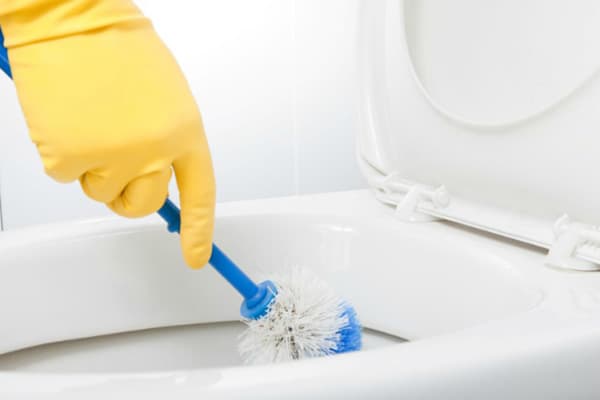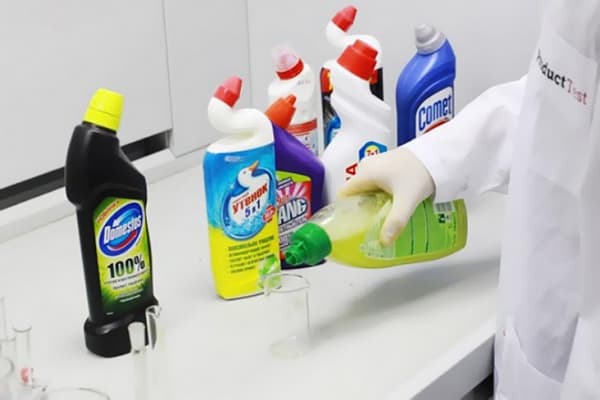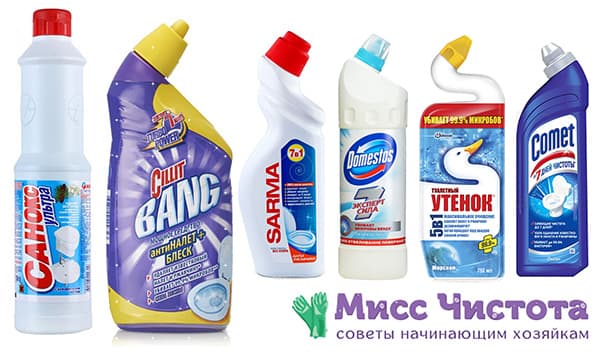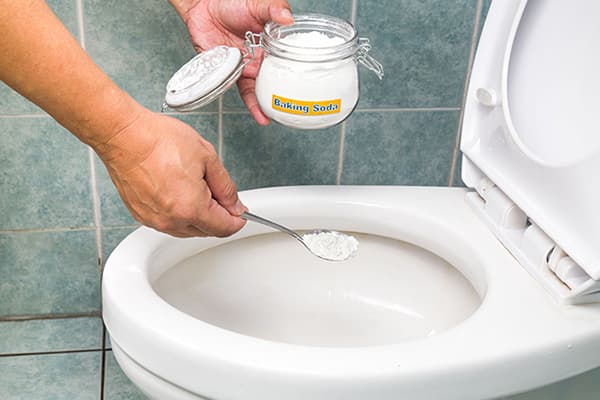How to choose a good toilet cleaner?
Home plumbing is considered to be the “face of the housewife”. The toilet, unlike the sink, is usually hidden from prying eyes. But this does not mean at all that he does not require attention. Lime deposits of varying degrees of neglect, urinary stone, rust, plaque, odors, bacteria - all this must be systematically gotten rid of. And not only for the purpose of “keeping the mark.” This is necessary to maintain hygiene in the bathroom, as well as to extend the life of the plumbing itself. There are a huge number of toilet bowl cleaning products available today, and it is sometimes difficult to make a choice. We have collected practical tips and tricks for you.

What is washed with what?
To cope with the task, you need to know what type of pollution there are and what substances fight them.
The main types of contamination in toilets:
- Lime deposits. This can be either plaque or large-scale, dense growths. The main reason for their occurrence is the presence of a large amount of salts in tap water, as well as its high hardness. Strong alkalis help dissolve lime.
- Rust. Quite often it occurs in houses with an old water supply and sewerage system, when pipes (of course, still metal) become corroded from the inside. And this rust, naturally, constantly ends up in the toilet with flushing water. By the way, rust often appears on the walls of the bathtub.The salvation from this scourge will be acid.
- Urine stone. It often forms if the toilet is not washed after every use or if the toilet bowl has roughness or damage in which bacteria that lived in the urine accumulate and multiply. Strong acids also help get rid of urinary stones.
- Plaque of household pollution, which inevitably appears on the surface of the toilet bowl. It is washed off well by surfactants (surfactants).
- Bacteria, causing an unpleasant odor, multiply in the bathroom constantly for natural reasons. They are successfully killed by toilet disinfectants containing chlorine or aggressive acids. And fragrances remove the “aroma” of the toilet and bleach. Such compositions can be used to treat plumbing fixtures not only in the toilet, but also in the bathroom. After all, disinfection occupies a leading place in matters of hygiene.
Of course, not all of these types of contaminants are necessarily present in every toilet. Therefore, the means must be chosen depending on the existing problems.
What types of cleaning products are there?
All plumbing care products can be divided into 2 main groups: those that are designed directly to combat problems, and those that serve to prevent their occurrence. The first include, for example:
- Cleaning gel. Its consistency allows the product to be applied evenly. At the same time, the gel dissolves contaminants and slowly flows down along with them. Often, gels are packaged in a bottle with a curved spout so that it can be applied even to the most difficult to reach places.
- Powder. Its main drawback is the need to constantly rub throughout the entire duration of action. Doing this is not as convenient as, for example, when cleaning a sink.In addition, powder particles can damage the bowl's coating over time.
- Cream. Gently cleans dirt without scratching the enamel of the toilet bowl. But it also needs to be applied and distributed manually.
- Liquid. Its main disadvantage is its uneconomical consumption: it quickly drains from the walls of the bowl.
The second group consists of softer and more gentle compositions, sometimes having an unusual shape. They are not intended for aggressive effects, but to prevent pollution and combat minor “current” problems:
- Cleaning tablets (balls, cubes, washers, etc.). They are attached to the toilet bowl in such a way that during flushing the water washes over them, gradually releasing cleaning and disinfecting substances.
- Blocks. They are reservoirs into which a gel-like substance is poured, or containers with several balls of different effects inside. They act in a similar way: they fall on the walls of the bowl when draining.
- Magnetic rings. They are installed not in the toilet bowl, but in the flush tank itself. They are quite expensive. But they work more efficiently than previous means.
In addition, there are many folk recipes for active and preventive cleaning of the toilet.
Popular brands
The following products are considered the most popular among consumers (and therefore the most effective):
- Domestos. It is a thick, viscous gel that is able to defeat quite complex stains thanks to the acid it contains. Kills pathogenic bacteria and fungi. It is distributed evenly and quite economically over the surface of the bowl due to its viscous consistency, and has a protective mechanism on the cap that does not allow children to unscrew it.However, after using the gel, it is necessary to thoroughly ventilate the room to get rid of the pungent odor.
- Cillit Bang. This is also a thick gel-like substance containing an aggressive acid – hydrochloric acid. The product copes well with the most serious toilet problems, but requires very careful use (this must be done exclusively with gloves), because hydrochloric acid can cause severe burns. The container has a convenient shape with a spout that delivers the gel to the most inaccessible places, and the thickness allows you to use the product economically. But at the same time, the bottle does not have child protection (which is strange for such a dangerous composition), and the price cannot be called low.
- "Toilet duckling" Produced by Russian manufacturers. Also a gel-like product, the bottle is equipped with a spout for application under the rim. Its base is the same hydrochloric acid, so it cleans and disinfects very effectively. In addition, the manufacturers have provided a protective mechanism against opening by children and added a pleasant fragrance. The price of the “duckling” is quite attractive. But it is not thick enough, which is why it is consumed somewhat faster.
- "Comet 7 days of cleanliness." The combination of chlorine and sulfuric acid provides active cleaning and maintenance of cleanliness after it for a week. This gel is used very economically, copes with the most persistent stains, and is childproof. True, the smell of chlorine is quite pronounced.
- "Sarma Gel for sanitary ware." The active ingredient is oxalic acid. Cleans well, whitens and refreshes the toilet for a long time, without having a pungent odor. The cap is childproof, and the product itself is attractively priced.But it copes poorly with significant limescale deposits.
- "Sanox Ultra". A high-quality domestic product based on sulfamic and oxalic acids. Very effective in removing rust stains, dirt, and limescale. Thanks to the fragrance it has a pleasant smell. It's a bit runny, so it gets used up quickly. In addition, it does not have a locking device on the cap, so small children can open it.
Keep your toilet clean regularly. Then serious problems that are difficult to cope with will not arise. And there will be no need to select a cleaning composition for them, because the best cleaning agent is prevention.
Traditional methods
How do thrifty housewives clean their plumbing? Old proven formulations that contain available homemade substances.
- Vinegar, citric acid, Coca-Cola. Their active ingredient is an acid that can dissolve plaque and remove dirt. Depending on the persistence of the stain, these products are applied for 20 minutes, an hour, or left overnight.
- Soda (regular or caustic - for more advanced cases). This is an alkali that can cope with fat and urinary stones. When using it, you need to scoop out all the water from the bowl, make a soda solution, pour it into the bowl, cover with a lid and leave for several hours. Then thoroughly scrub with a brush and rinse with water.
- "White". Thanks to the presence of chlorine, it perfectly cleans the toilet. “Whiteness” must be poured into the bowl overnight so that it destroys contaminants for at least 8 hours.
- Composition: one and a half glasses of peroxide, a tablespoon of ammonia and 2 liters of water. Works well against rust and yellow plaque.
If you have people in your family who suffer from allergies (and especially bronchial asthma), especially if you yourself are one of them, using products that have a strong odor to clean your plumbing can be dangerous. Therefore, choose the appropriate one from home recipes and maintain cleanliness at all times so that you do not have to use caustic drugs.
Home remedies can also help if you have sensitive skin on your hands, where industrial chemicals cause irritation, rashes, itching, peeling, and cracks.
So, there is no ideal cleaning composition that can cope with absolutely all problems and dirt at once. Each is designed to combat specific contaminants. This is due to the fact that each type of dirt is removed with certain substances, which cannot always be mixed in one preparation. Therefore, when choosing household chemicals to care for your plumbing, you need to focus, first of all, on the specific problem, as well as on the degree of its severity. Depending on this, the drug can be based on chlorine, acids or alkalis.
But, as already mentioned, the best way to always have a sparkling clean toilet, which even after many years of use will look like new, is to clean out all the dirt once and maintain hygiene constantly.


